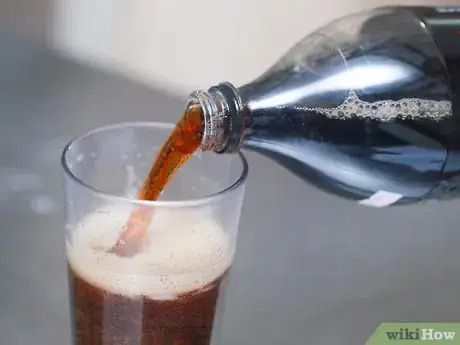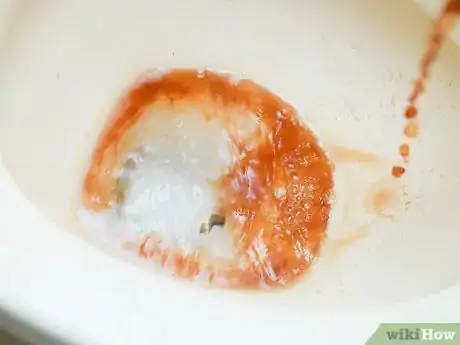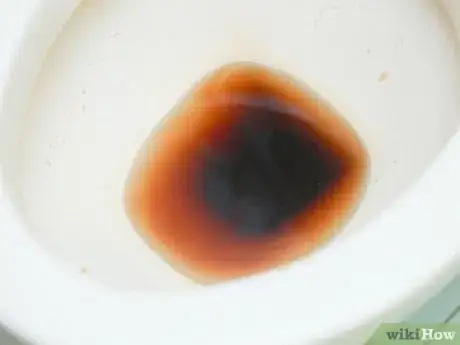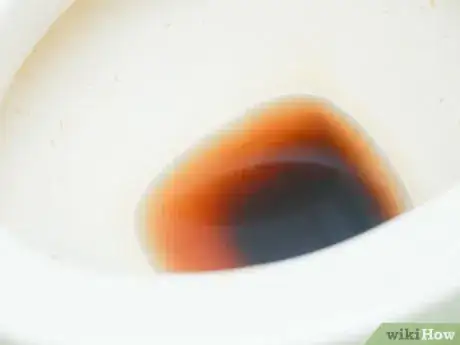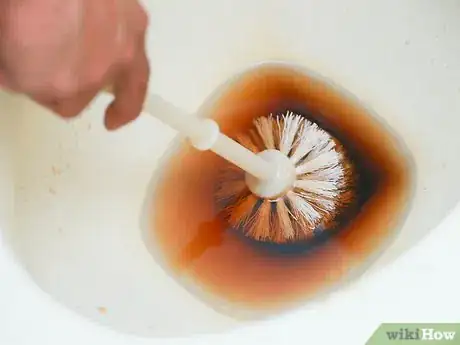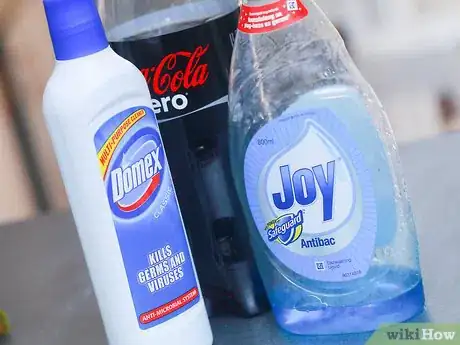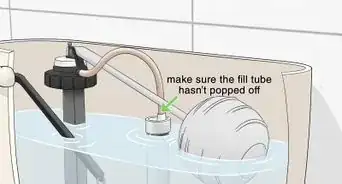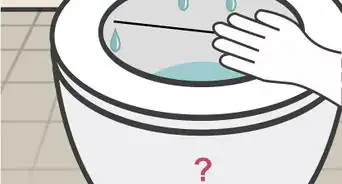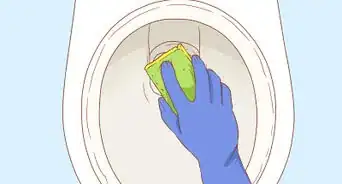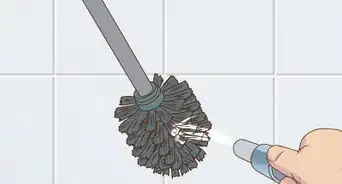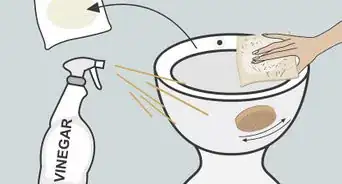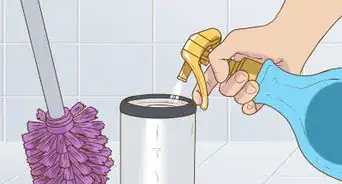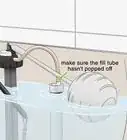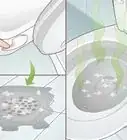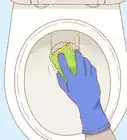wikiHow is a “wiki,” similar to Wikipedia, which means that many of our articles are co-written by multiple authors. To create this article, 57 people, some anonymous, worked to edit and improve it over time.
wikiHow marks an article as reader-approved once it receives enough positive feedback. This article received 18 testimonials and 94% of readers who voted found it helpful, earning it our reader-approved status.
This article has been viewed 2,073,564 times.
Learn more...
Coca-Cola isn't just a tasty beverage — its mild acidity makes it useful for commode-cleaning purposes. Are you looking for a way to deal with toilet limescale without shelling out cash for expensive bowl cleaners? Coke can often cost less than 50 cents per liter. Are you looking for non-toxic cleaning solutions? Coke is (obviously) perfectly safe for humans. Try these easy tricks today to start cleaning with Coke.
Steps
Regular Cleaning
-
1Measure out a cup or two of Coke. Open a bottle or can of Coke. You won't need much to clean your toilet — a standard-sized soda can contains 12 fluid ounces (350 ml) (1.5 cups), which should be plenty. If you have a bigger container of Coke, measure about this much and pour it into a glass.
- Coke works as a cleaner because of the gentle carbonic and phosphoric acid it contains. These chemicals come from the carbonation, not from the flavorings in the soda, so Diet Coke works just as well as regular Coke. This also means that club soda and many other carbonated beverages can be substituted for Coke (though these are rarely as cheap).
-
2Pour the Coke into the bowl. Pour the Coke around the rim of the bowl. Let it flow over the stains below. Be sure to give all the stains a good even coating of Coke — it will appear to wash into the bottom of the bowl, but a thin coat will remain on the stain.
- For stains high in the bowl that is hard to reach, try soaking an old rag in Coke and applying it by hand. You can also use a spray bottle filled with Coke if you prefer not to get your hands dirty.
Advertisement -
3Let the Coke sit. Patience is key. The longer you let the Coke sit, the more of a chance you give the acids in the Coke to break down the stains.[1] Try to let the Coke sit for at least an hour without disturbing it.
- For extra cleaning power, pour the Coke in before you go to bed and let it sit in the toilet overnight.[2]
-
4Flush. While you let the Coke sit, the acids will slowly loosen the built-up stains in the bowl. Now, flush the toilet once. The loosened stains should be (at least partially) rinsed away with the toilet water.
-
5Repeat as needed. At this point, you can see how well the Coke was able to remove the stains. While Coke usually works well for the sorts of rings and built-up mineral stains that are common problems in toilets, it may not completely eliminate every stain. If desired, simply re-apply a second layer of Coke and repeat the process.
- If your stains just won't seem to go away with a second application of Coke, check out the section below, which has suggestions for especially hard-to-remove toilet stains.
For Persistent Stains
-
1Use lots of scrubbing. A good old-fashioned toilet brush is your best bet if simple flushing won't remove your stains. The mechanical action of a brush (or a similar item, like an abrasive pad) will further loosen built-up stains and help remove them from the walls of the bowl after you've treated them with Coke.[3] Be sure to wash your hands after scrubbing and wear gloves if germs make you squeamish.
- For best results, scrub before and after using the Coke. In other words:
- Open the bowl and scrub the stains with the brush.
- Apply the Coke.
- Let the Coke sit.
- Scrub once again with the brush and flush to rinse the stains away.
-
2Use heat. In general, chemical reactions happen much more quickly at high temperatures. The acid reactions that allow Coke to remove stains from toilet bowls are no exception. For difficult stains, try heating up your Coke in the microwave before you apply it to the bowl. It doesn't need to be boiling, but for best results, it should be hot to the touch, so use caution when handling the hot Coke.
- Never microwave soda (or any liquid) in a sealed container or a container made of metal. This can lead to dangerous explosions of hot liquid. Instead, pour the soda into a microwave-safe glass (like one made of glass or ceramic), then microwave it.
- Heating Coke will make it fizz slightly more than normal, so you may want to wear gloves to avoid getting splashed with tiny drops of soda.
-
3Use Coke along with other household cleaners. While Coke can remove many stains, it's not always the absolute best cleaning agent for the job. For very difficult stains, you may want to try pairing it with other cleaning solutions. Here are some other cleaning methods you can try with items around the house:
- Try mixing 1/2 cup vinegar and 1/4 cup baking soda (or 2 teaspoons borax) into 1/2 gallon (2 liters) jug of water. Apply the mixture to the toilet bowl, scrubbing and waiting an hour before flushing. Follow with Coke treatment as needed.
- For mold, try mixing one part hydrogen peroxide with two parts water in a spray bottle. Spray it onto the moldy surface, let sit at least one hour, and scrub until the mold dissolves. Use Coke to remove any residual stains or scaling around the moldy spot.
- Try mixing two parts borax with one part lemon juice and one part Coke for another versatile cleaning agent. Apply the mix to the toilet bowl, let it rest an hour, then scrub off the stains.
-
4Know when Coke isn't the best choice. Coke is suitable for most of the mineral deposits and rings that commonly occur in toilets. However, it won't always work for rarer stains, so other solutions are sometimes necessary. See below:
- Coke isn't great for removing oil, fat, or grease-based stains. For these, you're better off using dish soap, detergent, or a stronger acid like vinegar.[4]
- Coke isn't great at killing germs. In fact, the sugary residue left behind by regular Coke can actually feed certain types of bacteria. Stick to soap, a commercial cleaning solution, or an alcohol-based sanitizer to kill microorganisms.
- Coke won't remove stains caused by inks, dyes, or pigments. Rubbing alcohol and other chemical solvents are often the best choice here.[5]
Community Q&A
-
QuestionDoes Pepsi do the same thing?
 Community AnswerNo. Pepsi has a lower acidity than Coke due to the higher sugar content.
Community AnswerNo. Pepsi has a lower acidity than Coke due to the higher sugar content. -
QuestionCan I use baking soda in the tank?
 Community AnswerYes, you can use baking soda in the tank, but it might not be as effective as bleach.
Community AnswerYes, you can use baking soda in the tank, but it might not be as effective as bleach. -
QuestionHow can we get the mess off the top of the stove?
 Community AnswerI've heard to use lemon juice and baking soda. Let it sit for about a half hour and the grime comes off like butter.
Community AnswerI've heard to use lemon juice and baking soda. Let it sit for about a half hour and the grime comes off like butter.
References
- ↑ https://www.cnet.com/pictures/things-you-can-clean-with-coke/2/
- ↑ https://www.bobvila.com/slideshow/power-up-your-cleaning-routine-with-caffeine-48411?slide=2
- ↑ https://www.bobvila.com/slideshow/9-things-you-didn-t-know-coca-cola-can-do-48739?slide=4
- ↑ http://home.howstuffworks.com/home-improvement/household-hints-tips/cleaning-organizing/5-great-ways-to-clean-grease.htm
- ↑ http://www.housecleaningcentral.com/en/cleaning-tips/stain-removal/remove-ink-stain.html
- ↑ http://www.snopes.com/cokelore/acid.asp
About This Article
To clean a toilet with Coke, pour 1-2 cups of Coke into a glass, and bring the glass into the bathroom. Then, pour the Coke over the stains around the bowl of the toilet, coating the walls while it flows into the water. Let the soda sit in the toilet for at least an hour to break down the stains, and then flush the toilet to wash away the stains with the Coke. Repeat as needed until the stains are eliminated! For more tips on removing persistent stains, scroll down!
